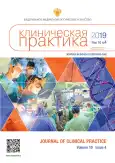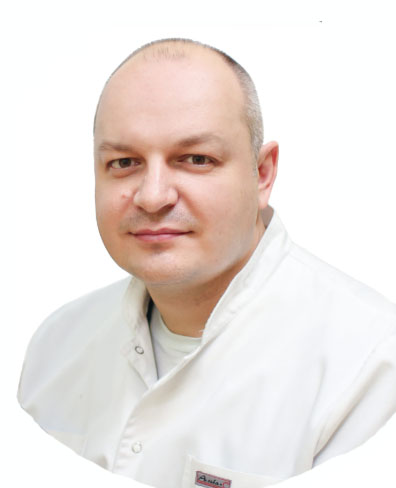Том 10, № 4 (2019)
- Год: 2019
- Выпуск опубликован: 13.12.2019
- Статей: 13
- URL: https://clinpractice.ru/clinpractice/issue/view/1084
Оригинальные исследования
Оценка влияния эндоваскулярного доступа на эффективность и безопасность химиоэмболизации артерий печени при нерезектабельных метастазах в печень
Аннотация
Актуальность. В лечении первичного и метастатического рака печени широко используются методы минимально инвазивной хирургии.
Цель — изучить влияние эндоваскулярного доступа на эффективность и безопасность химиоэмболизации артерий печени у пациентов с нерезектабельными метастазами в печень.
Методы. У 30 пациентов с нерезектабельными метастазами в печень выполнена химиоэмболизация печеночных артерий (ХЭПА) с использованием трансрадиального и трансфеморального доступа. Применена микрокатетерная техника для суперселективной химиоэмболизации артерий печени с введением лекарственно-насыщаемых микросфер. Весь цифровой материал обработан с использованием пакета программ STATISTICA 6.0 (StatSoft, 2001). Результаты считались статистически значимыми при p<0,05.
Результаты. При нормальном варианте кровоснабжения печени только левый лучевой доступ в объеме вмешательства на уровне эмболизации только правой печеночной артерии продемонстрировал достоверно наименьшую длительность ХЭПА и рентгеноскопии, которые составили 33±4,3 и 9,9±1,3 мин соответственно (р<0,05). При выполнении ХЭПА с помощью эмболизирующих микросфер 50–100 мкм из правого бедренного доступа в объеме эмболизации только правой печеночной артерии вышеперечисленные оценочные критерии были наиболее высокими — 67±11 и 19,1±5,3 мин соответственно, однако без достоверных отличий между остальными вариантами пункционного доступа. При проведении первой ХЭПА с использованием трансфеморального доступа количество послеоперационных койко-дней у исследуемых пациентов составило 7±0,8 дня, а постэмболизационный период длился 1,43±0,5 сут, что достоверно больше (при р≤0,05) в сравнении с аналогичными показателями при артериальном правом лучевом доступе, где эти показатели были 3±0,6 дня и 1,15±0,4 сут, и при артериальном левом лучевом доступе — 4±0,5 дня и 1±0,001 сут соответственно.
Заключение. Применение эмболизирующих микросфер позволило использовать микрокатетерную технику для проведения hqTACE и расширило возможности трансрадиального доступа. Достоверно лучшие переносимость и безопасность трансрадиального доступа были доказаны у 76,2% исследуемых пациентов, у которых он был применим. Кратность ХЭПА не влияет на тяжесть постэмболизационного периода, в том числе за счет меньшего использования контрастного вещества и суперселективной эмболизации пораженных участков печени с сохранением большего количества интактной паренхимы.
 5-15
5-15


Компьютерная томография в диагностике заболеваний тонкой кишки
Аннотация
Введение. Актуальность работы обусловлена трудностями диагностики заболеваний тонкой кишки. Ввиду распространенности и широкого внедрения в клиническую практику рентгеновской компьютерной томографии ее возможности в диагностике заболеваний тонкой кишки представляют большой интерес и потенциал.
Цель — раскрытие возможностей компьютерной томографии с применением внутривенного болюсного контрастного усиления в выявлении симптома «утолщения стенки» тонкой кишки и ее прогностической значимости при различных нозологиях.
Методы. Анализ данных исследований мультиспиральной компьютерной томографии, выполненных по протоколу исследования органов брюшной полости с применением внутривенного болюсного контрастного усиления и перорального приема воды взрослым пациентам от 18 до 87 лет с заболеваниями тонкой кишки.
Результаты. В работе показаны возможности мультиспиральной компьютерной томографии, выполняемой по стандартному протоколу, в выявлении утолщения стенки тонкой кишки. Определен круг заболеваний, для которых утолщение стенки тонкой кишки являлось одним из основных рентгенологических симптомов поражения. Представлена прогностическая значимость этого рентгенологического симптома. Описаны особенности утолщения стенки кишки при различных заболеваниях и другие отличительные признаки, которые можно использовать в дифференциальной диагностике.
Заключение. Утолщение стенки — распространенный признак поражения тонкой кишки, который убедительно обнаруживается при КТ-исследовании с болюсным контрастным усилением. В нашей выборке частыми причинами утолщения стенки тонкой кишки при первичном заболевании являлись болезнь Крона (37%), лимфома (20%), анастомозит (13%). Однако утолщение стенки тонкой кишки в 7% определено нами как следствие первичных опухолей (аденокарцинома, саркома) и в 18,6% — как следствие вторичного опухолевого поражения. Рассмотренные заболевания были различны по степени утолщения стенки кишки (от 6 до 70 мм), ее протяженности (фокальное утолщение 48%; сегментарное 52%), количеству пораженных участков (от 1 до 3), их локализации (проксимальный — средний или дистальный участок), форме перехода пораженной части кишки в неизмененную (резко очерченный или плавный), наличию или отсутствию симптомов кишечной непроходимости и особенностям контрастного усиления (степень выраженности и тип).
 16-29
16-29


Сравнение стратегий реваскуляризации миокарда у пациентов с ишемической болезнью сердца и многососудистым поражением венечных артерий
Аннотация
Обоснование. До сегодняшнего дня не теряет актуальности проблема выбора метода полной реваскуляризации у категории пациентов с острым коронарным синдромом без подъема сегмента ST и многососудистым поражением коронарного русла.
Цель — сравнение результатов оперативных манипуляций у пациентов, перенесших чрескожное коронарное вмешательство (группа ЧКВ) с использованием стентов 3-го поколения с лекарственным покрытием и аортокоронарное шунтирование (группа АКШ), по данным двухлетнего наблюдения.
Методы. Выполнено сравнение результатов хирургической и эндоваскулярной стратегии реваскуляризации у 140 пациентов с ишемической болезнью сердца и многососудистым поражением коронарного русла после ранее успешно выполненного стентирования клинико-зависимой артерии с использованием стентов 3-го поколения с лекарственным покрытием по поводу острого коронарного синдрома без подъема сегмента ST по результатам двухлетнего наблюдения.
Результаты. Статистически значимых различий по клинико-демографическим и операционным характеристикам между группами не выявлено, за исключением количества курящих пациентов, число которых достоверно больше в группе ЧКВ. В группе ЧКВ наблюдалась статистически значимая разница в частоте повторных реваскуляризаций и комбинированной точке MACCE.
Обсуждение. Полученные результаты показали преимущество АКШ в группе пациентов с успешно выполненным ранее ЧКВ клинико-зависимой артерии по поводу острого коронарного синдрома без подъема сегмента ST и многососудистого поражения.
Заключение. У пациентов с ишемической болезнью сердца и многососудистым поражением коронарного русла, перенесших успешно выполненное стентирование клинико-зависимой артерии с использованием стентов 3-го поколения с лекарственным покрытием по поводу острого коронарного синдрома без подъема сегмента ST и промежуточной тяжестью поражения по шкале SYNTAX при выполнении полной функциональной реваскуляризации методами аортокоронарного шунтирования или стентирования, не имеется различий по показателям сердечно-сосудистой смертности, инфаркта миокарда, острого нарушения мозгового кровообращения, частоты возврата клинических проявлений стенокардии, за исключением частоты повторных реваскуляризаций и комбинированной точки MACCE, которые статистически значимо выше были в группе стентирования.
 30-35
30-35


Влияние курения на распространенность респираторных симптомов у людей молодого возраста
Аннотация
Обоснование. Курение является предупреждаемым фактором риска хронических болезней органов дыхания.
Цель — изучить распространенность курения и оценить его влияние на распространенность респираторных симптомов у населения молодого возраста.
Методы. На основании анкеты GA2LEN проведен опрос 1252 жителей в возрасте 15–24 лет (отклик — 85,0%) одного из районов Москвы. Статистический анализ проведен с помощью пакета программ Statistica v. 10; EPINFO v. 7 (WHO).
Результаты. Распространенность курения составила 13,2% среди мужчин и 13,0% среди женщин (p=0,895). Регулярное курение у молодых людей зарегистрировано с возраста 10 лет и старше. Интенсивность курения у мужчин была выше, чем у женщин. Распространенность респираторных симптомов у курильщиков была выше, чем у некурящих. На хрипы в груди указали 19,1% некурящих и 26,3% (p<0,001) курящих мужчин, а также 15,9% некурящих и 29,5% курящих (p<0,001) женщин, на симптомы аллергического ринита в последние 12 мес — 19,3 и 30,3% (p<0,001) мужчин и 33,0 и 38,6% (p=0,009) женщин, на заложенность носа в течение 12 нед и дольше — 20,3 и 25,0% (p=0,012) мужчин и 18,1 и 27,3% (p<0,001) женщин соответственно.
Заключение. Неблагоприятное влияние курения на респираторное здоровье людей молодого возраста требует активной профилактики для снижения распространенности респираторных симптомов и тяжести течения хронических болезней органов дыхания.
 36-45
36-45


Технология интраоперационного нейромониторинга методом полипрограммной электростимуляции при операциях реконструктивной нейропластики
Аннотация
Введение. При операциях на лице и шее в качестве страховки используют технологию интраоперационного нейрофизиологического нейромониторинга.
Цель — разработка технологии интраоперационного нейромониторинга и практическая оценка ее эффективности в операциях реконструктивной нейропластики.
Методы. У 120 пациентов с параличом мимических мышц после удаления невриномы мостомозжечкового угла и повреждения лицевого нерва выполнены операции нейропластики с целью восстановления иннервации. Разработана оригинальная технология идентификации и мониторинга функционального состояния нервов и мышц — интраоперационный визуальный нейромониторинг. Его суть заключается в электростимуляции нервов в операционном поле и визуальном наблюдении ответных мышечных сокращений. Для интраоперационного визуального нейромониторинга создан специальный электростимулятор ЭСВМ-1 с набором встроенных тестовых программ. Управление электростимулятором, выбор тестов, их запуск, визуальное наблюдение реакций и собственно интраоперационный визуальный нейромониторинг осуществляет сам хирург.
Результаты. Данная технология избавляет от использования комплекса оборудования для нейрофизиологического мониторинга и не требует участия в операции специалиста-нейрофизиолога.
Заключение. Применение интраоперационного визуального нейромониторинга в ходе операции предоставляет возможность оценивать функциональное состояние лицевого нерва и мимических мышц, корректировать план оперативного вмешательства и ускорять его выполнение.
 46-52
46-52


Научные обзоры
Роль нимодипина и сульфата магния в профилактике сосудистого спазма и лечении ишемии головного мозга у больных в остром периоде разрыва церебральных аневризм
Аннотация
Сосудистый спазм у больных с кровоизлиянием из разрыва церебральных аневризм является основной причиной неблагоприятных исходов заболевания. Одним из способов лечения стойкого сокращения церебральных артерий является применение нимодипина и сульфата магния. В данном обзоре литературы представлены исследования по применению нимодипина и сульфата магния в лечении сосудистого спазма, освещены основные звенья патогенеза и механизмы действия препаратов.
 53-60
53-60


Спондилоартроз: патогенез, клиника, диагностика и лечение (обзор литературы и собственный опыт)
Аннотация
У 85–90% людей пожилого возраста диагностируется спондилоартроз. В специализированной литературе существуют разные синонимы данной патологии: фасеточный синдром, фасеточный болевой синдром, фасет-синдром, артроз межпозвонковых суставов, артроз дугоотростчатых суставов и спондилоартропатический синдром. В работе разобраны патогенез, клиническая картина и способы диагностики данного заболевания. Представлены современные виды консервативного и оперативного лечения. Проанализированы преимущества и недостатки хирургических методов лечения фасет-синдрома: аппаратная дерецепция (радиочастотная, лазерная и т.д.), химическая дерецепция и интраартикулярное введение препаратов. Представлены собственные результаты клинической работы. Денервация дугоотростчатых суставов представляется продуктивным малоинвазивным методом лечения рефлекторных форм спондилоартроза, который приводит к стойкому снижению интенсивности болей и улучшению качества жизни при низком риске развития периоперационных осложнений в раннем и отдаленном послеоперационном периодах.
 61-73
61-73


Лечение больших, массивных невосстанавливаемых повреждений вращательной манжеты плечевого сустава
Аннотация
Вращательная манжета плечевого сустава (ВМП) относится к сложной анатомо-биомеханической структуре, помогающей стабилизировать плечевой сустав в правильном положении и производить в нем движения. Повреждения ВМП остаются наиболее частыми среди повреждений других анатомических структур плечевого сустава и, по данным ряда авторов, достигают 21%. На фоне дегенеративных изменений в структуре ВМП у пожилых пациентов такие повреждения склонны к жировой перестройке мышечной ткани. Такие повреждения сложны в своем восстановлении, а количество рецидивов после оперативного лечения по разным данным варьирует в очень широком диапазоне (20–90%). По результатам изучения неудач послеоперационного вмешательства внедрены альтернативные методики по замещению, трансферу или пластике поврежденных сухожилий, но до сих пор нет единого подхода в лечении данной патологии. В представленном литературном обзоре проанализирован материал по анатомической структуре и биомеханике ВМП, роли повреждения ВМП в нарушении функции плечевого сустава и возможные методы по ее восстановлению.
 74-80
74-80


Некоронарогенные причины повышения тропонинов в клинической практике
Аннотация
Кардиоспецифические изоформы тропонинов являются наиболее чувствительными и специфическими биомаркерами для диагностики острого инфаркта миокарда. Однако повышенные уровни тропонинов указывают на повреждение миокарда, но не определяют причину и механизм повреждения. С помощью новых высокочувствительных методов можно обнаружить очень незначительные повреждения сердечной мышцы. Повреждения миокарда могут возникать при многих некоронарогенных заболеваниях. В данном обзоре мы обсуждаем механизмы элевации, диагностическое значение сердечных тропонинов при почечной недостаточности, тахиаритмиях, эндокардитах, миокардитах, перикардитах, сепсисе, нейрогенных патологиях (инсульт, субарахноидальные кровоизлияния), тромбоэмболии легочной артерии. Кроме того, мы уделяем внимание основным ложноположительным причинам повышения концентрации сердечных тропонинов — гетерофильным антителам, ревматоидному фактору, щелочной фосфатазе, перекрестным реакциям с тропонинами скелетных мышц.
 81-93
81-93


Клинические случаи
Клинический случай сифилитического мезаортита, осложненного аневризмой аорты
Аннотация
Современная эпидемиологическая картина сифилиса такова, что выявляемость сифилитического мезаортита как проявления кардиоваскулярной патологии при третичном сифилисе составляет лишь 10% случаев. Одним из наиболее частых и серьезных осложнений такого мезаортита является аневризма аорты. Неспецифичность симптомов и клинического течения подобных аневризм порой затрудняет своевременное выявление патологии, что приводит к высокой смертности на госпитальном этапе. В данной статье описывается редкий случай диагностики сифилитического мезаортита, осложненного аневризмой аорты.
 94-98
94-98


Хроническая паховая боль после лапароскопической трансабдоминальной преперитонеальной герниопластики при паховой грыже
Аннотация
Повсеместное выполнение паховых герниопластик различными методиками не исключает возникновения поздних послеоперационных осложнений, причину которых установить иногда крайне тяжело. В статье описывается клинический случай наблюдения больного, имеющего хроническую послеоперационную боль через 6 мес после паховой герниопластики по методике ТАРР. При изучении возможных причин было обнаружено наличие фиксирующего материала (такеры) в треугольнике боли, удаление последних привело к полному нивелированию клинической картины. Таким образом, несмотря на простоту выполнения паховой герниопластики, желание хирурга к чрезмерной фиксации и нарушение принципов выполнения данной операции может привести к нежелательным осложнениям и временной инвалидизации пациента.
 99-103
99-103


Дискуссии
Как выбрать хирургическую тактику для рака пищеводно-желудочного перехода?
Аннотация
Стандартная хирургия для опухолей пищеводно-желудочного соединения, особенно для аденокарциномы, до сих пор остается спорной. Различные способы были предложены и разрешены для опухолей Siewert типа II. Решение об объеме резекции и размере отступов с каждой стороны определяет выбор той или иной операции. Вместе с тем недавно было показано, что приоритетным фактором в выборе способа резекции является длина инвазии для каждой стороны (пищевода и желудка), потому что это определяет частоту и локализацию метастазирования в лимфатические узлы, которые должны быть удалены. При проксимальной гастрэктомии важным фактором является также размер культи желудка.
 104-108
104-108


Хирургическое лечение рака пищеводно-желудочного перехода. Обсуждение тактики
Аннотация
Введение. В настоящее время не существует стандартизированной хирургической тактики для лечения рака пищеводно-желудочного перехода. Дискутабельными остаются вопросы об отступе края резекции, объеме лимфодиссекции и оптимальном размере культи желудка. В статье рассматривается влияние данных параметров на безрецидивную выживаемость и послеоперационное качество жизни пациентов по данным литературы.
Цель исследования — анализ исходов лечения пациентов с раком пищеводно-желудочного перехода в зависимости от хирургической тактики. В статье проанализированы данные литературы, оценивающие различные подходы при хирургическом лечении рака пищеводно-желудочного перехода. Приведен пример результатов лечения пациента с аденокарциномой проксимального отдела желудка с глубиной инвазии Т3 и хирургической тактики в отношении размера культи желудка в исследовании Yasuyuki Seto. Показано большое преимущество отступа края резекции от проксимального края на 2 см, от дистального — на 5 см. Пациенту с аденокарциномой проксимального отдела желудка с глубиной инвазии Т3 была проведена резекция с отступом проксимального и дистального края 13 и 65 мм соответственно. Интраоперационно диагностированы отрицательные края резекции. Безрецидивная выживаемость пациента составила 6 лет. Тотальная гастрэктомия или эзофагэктомия не являются операциями выбора в связи с ухудшением качества жизни пациентов. При анализе степени инвазии по данным литературы было установлено, что инвазия в сторону пищевода более 30 мм ассоциирована с повышенным риском наличия метастатических лимфатических узлов верхнего и среднего средостения. При длине инвазии желудка более 40 мм поражаются лимфатические узлы малой кривизны вдоль правой желудочной артерии. По данным литературы, благоприятным в плане послеоперационного качества жизни являлся размер культи желудка более 2/3 размера органа. Многими авторами указывается положительное влияние сохранения желудочно-пищеводного сфинктера и кардии желудка. В исследовании Yasuyuki Seto проксимальная резекция желудка применялась только в случае сохранения размера культи желудка более 12 см по малой кривизне и 25 см по большой кривизне.
Заключение. При выборе хирургической тактики при раке пищеводно-желудочного перехода необходимо ориентироваться на качество жизни пациента после операции. Необходимо добиться отрицательных краев резекции в каждом случае. Отступ должен составлять более 2 и 5 см для проксимального и дистального краев соответственно. Лимфодиссекция лимфатических узлов среднего и верхнего средостения должна осуществляться при инвазии опухоли в пищевод более чем на 30 мм, удаление лимфатических узлов малой кривизны желудка по ходу правой желудочной артерии должно быть применено при инвазии опухоли в желудок более 40 мм. Оптимальным является сохранение культи желудка не менее 2/3 размера органа. Вопрос хирургической тактики при раке пищеводно-желудочного перехода имеет большую практическую значимость и требует дальнейшего изучения.
 109-114
109-114













